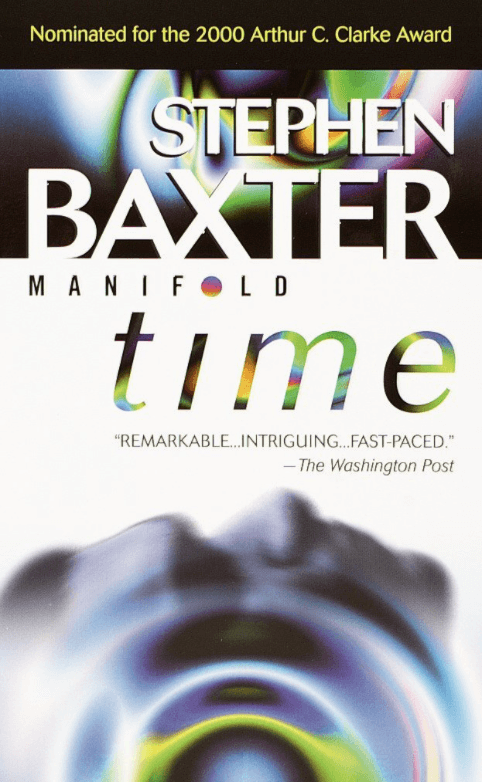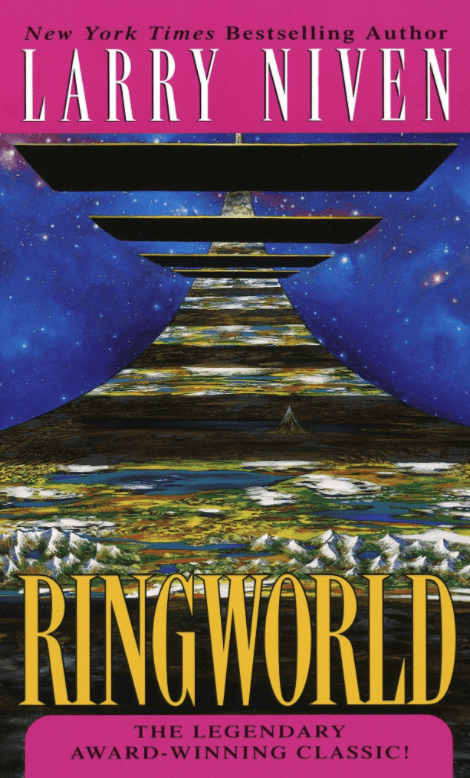
Some sci fi is scarcely distinguishable from fantasy. In fact, some of it is fantasy, just set in space or set in the future. Plot points like telepathy, teleportation, strange aliens, and faster-than-light travel are attributed to explanations that amount to little more than “magic.”
“Hard science fiction” grapples with the “science” in its moniker. While not slave to the possible, the great hard science fiction books reach for the plausible. They start with what we know about science and the physical world, then take it one, maybe two steps into a credible future. Sometimes these projections border on prophetic—hard science fiction books envisioned artificial intelligence, virtual reality, the Internet, genetic engineering, and other tech leaps years or even decades before they became a reality.
The best hard science fiction books excite the mind with the possibilities of human ingenuity–or raise alarm bells about pitfalls lying in wait a few steps ahead of the gears of progress. Here are our picks for the 14 best hard science fiction books.
1- Altered Carbon by Richard Morgan
Amazon
Altered carbon
4 used from $7.89
Features
| Release Date | 2018-02-15T00:00:01Z |
| Language | Italian |
| Publication Date | 2018-02-15T00:00:01Z |
Who said science can’t be fun? Or violent or pruriently sexy? Anyone who said that forgot to copy Richard Morgan on the memo, because his lurid crime potboiler set in an interplanetary future is a gas and a half.
The star technology of this hard science fiction book is the “cortical stack.” This is a device implanted in most human brains that stores the personality, like a data drive creating a backup. When the person dies, the stack can be downloaded (or “re-sleeved”) into a new body, allowing humans effective immortality. Almost anyone can afford this, but only the wealthy who can afford a constant supply of young “sleeves” actually choose to never die. After all, who wants to grow old and decrepit multiple times. And, of course, Catholics refuse to re-sleeve because they believe they go to heaven. Classic.
Then there’s the subject of incarceration—why waste a perfectly good sleeve when you can just imprison the “stack?” Into this milieu, an imprisoned stack named Kovacs, with a background in training as a deadly “Envoy” interplanetary soldier, is resleeved to solve the murder of a wealthy man. Of course, the murder victim isn’t actually dead—he has been re-sleeved—but with a mysterious gap in his memory that obscures the identity of the killer.
Kovacs’ quest to catch the killer leads him to take the illegal step of “double-sleeving”—controlling two bodies with one personality from the same cortical stack. The ethics are mind-bending.
2- Ancillary Justice by Ann Leckie
Amazon
Ancillary Justice (Imperial Radch (1))
$14.80 in stock
97 used from $1.71
Free shipping
Features
| Part Number | unknown |
| Release Date | 2013-10-01T00:00:01Z |
| Edition | Later Printing |
| Language | English |
| Number Of Pages | 416 |
| Publication Date | 2013-10-01T00:00:01Z |
Whereas Altered Carbon dances around the implications of controlling two bodies with one consciousness, Ancillary Justice makes it the crux of the novel, set in an evocative far future dominated by a human interplanetary empire called Radch. The Radchai use artificial intelligence to guide ships and also to control human bodies, called “ancillaries.”
Set on a remote ice planet, the novel focuses on Breq, an ancillary whose consciousness is a fragment leftover from the destruction of an AI ship called the Justice of Toren. Breq’s quest for answers about the ship’s destruction is also a quest for justice, since Breq was a part of the ship’s AI.
The twisty plot ultimately indicates that this vast empire is ruled by one warlord, who has downloaded his consciousness into multiple ancillaries to rule multiple corners of the galaxy simultaneously until, predictably, those ancillary personalities go to war with one another. Talk about being at war with yourself—this is a whole different level.
3- Downbelow Station by C. J. Cherryh
Amazon
Features
| Language | English |
| Number Of Pages | 30 |
| Publication Date | 1989T |
The best hard science fiction books are plausible. They reflect the present day and present a future that seems like it could happen, and perhaps even inevitably will happen. Decades before Elon Musk got into the space-exploration business, Cherryh envisioned the Alliance-Union universe, where governments were too short-sighted to pursue space travel, and as a result the galaxy was populated by a private corporation—the creepy-sounding spacefaring monopoly Earth Company.
Downbelow Station takes place in the last days of the “Company Wars,” an interstellar battle between Earth Company and the breakaway Union. It also focuses on Pell’s Station, or “Downbelow Station,” in orbit around Pell’s World, aka “Downbelow,” the first discovered habitable planet. From refugee crises to colonial imperialism to artificially-bread spies, the predictions of Downbelow Station don’t feel very far-removed from reality at all.
4- Dragon’s Egg by Robert L. Forward
Amazon
Dragon's Egg: A Novel (Del Rey Impact)
$16.99 in stock
20 used from $3.52
Free shipping
Features
| Part Number | unknown |
| Release Date | 2000-02-29T00:00:01Z |
| Edition | Reprint |
| Language | English |
| Number Of Pages | 352 |
| Publication Date | 2000-02-29T00:00:01Z |
It sounds like a “Game of Thrones” knockoff, but the astrobiology Forward conceives of in Dragon’s Egg is far stranger and more fantastic than anything in a fantasy novel, all of it rooted in principles of physics and chemistry like the best hard science fiction books. The concept was adapted into one of the best episodes of Star Trek: Voyager, “In the Blink of an Eye,” but the book digs into delicious detail.
The “Dragon’s Egg” refers to a neutron star, near the tail of the constellation Draco, on course to pass close to Earth. The human visitors discover, shockingly, that the surface of the neutron star has cooled, given rise to a strange kind of biochemistry, culminating in the evolution of an intelligent life form.
Forward has a lot of fun with the strange biology of his neutron-star inhabitants, the Cheela. Because of the intense gravity of a neutron star (the mass of half a sun about 12km across), each Cheela is about the size of a sesame seed and can view light in the ultraviolet and X-ray wavelength. They also have a much shorter life cycle than humans, with each Cheela year taking about 30 Earth seconds.
When the Earthlings encounter the Cheela, they are a primitive, violent society. In the months they spend in orbit of the Dragon’s Egg, the Cheela advance into a technological society that surpasses Earth’s own. At first the generations of Cheela worship the human spaceship in the sky, with whom they cannot communicate, as a God, but when the spaceship leaves, the advanced Cheela patronizingly refer to the humans on the ship as the “Slow Ones.”
5- Foundation by Isaac Asimov
Amazon
Foundation
$8.36 in stock
111 used from $1.49
Features
- Used Book in Good Condition
There had been great hard science fiction books before 1951, but nobody was ready for Foundation, Isaac Asimov’s sprawling opus of humanity on the edge. Like the best hard science fiction books, it is prescient. The starting point of Foundation is Asimov’s made-up discipline “psychohistory,” a science that allows its practitioners to reduce historical vectors to mathematical equations, which they can then use to accurately predict the future. It’s easy to see big data and AI analytics leading to something like this.
The original Foundation novel is actually a collection of five interrelated novellas, set against the backdrop of a 12,000-year-old galactic empire in decline. In another echo of the plausible, the decadent empire is not very interested in news of its own impending destruction and the ensuing 30,000-year dark age, as predicted by the psychohistorians.
The century-spanning story follows the imperial exiles who follow the psychohistorians to a remote outpost and the project of compiling an Encyclopedia Galactica, in an effort to reduce the dark age to 1,000 years. It’s a mind-blowing exploration of causality, uncertainty, and destiny.
6- Red Mars by Kim Stanley Robinson
Amazon
Red Mars (Mars Trilogy)
68 used from $2.29
Free shipping
Features
| Part Number | 9780553560732 |
| Color | Black |
| Release Date | 1993-10-01T00:00:01Z |
| Edition | Reprint |
| Language | English |
| Number Of Pages | 572 |
| Publication Date | 1993-11-01 |
Red Mars is the first in a trilogy of books that documents a “very-near-future” effort to terraform Mars, with subsequent books Green Mars and Blue Mars continuing the saga. Coincident with the end of the Cold War, Robinson also foregrounds an optimistic vision of Russians and Americans running Mars operations jointly.
It isn’t all sunshine and roses on Mars, though. Robinson’s characters engage in several heady debates that will no doubt rear their heads if real-life space colonization ever becomes a thing. Do humans have the right to bend whole planets to their will? Do they have an obligation to do so, considering the rarity and preciousness of life? Should a new planet be subject to new traditions, or is there something inherently human about our traditions that we carry with us, whatever planet we set foot on?
Meanwhile, back on Earth, transnational corporations corrupt governments, with a consequence that violent conflict breaks out on Mars. It’s a gripping start to an ultimately fairly utopian hard science fiction book.
7- Rendezvous with Rama by Arthur C. Clarke
Amazon
Rendezvous with Rama
$7.09 in stock
23 used from $3.11
Features
| Part Number | 1733567 |
| Release Date | 1990-11-01T00:00:01Z |
| Language | English |
| Number Of Pages | 288 |
| Publication Date | 1990-12-01T00:00:01Z |
As author of 2001: A Space Odyssey, Clarke already had some experience with a mission to Jupiter to encounter a strange, alien object. Rendezvous with Rama reiterates some of these tropes, but in more of a hard science fiction context, without the “magic” or the speculation of alien involvement in human development.
Rendezvous also offers an early contrast to pulp sci fi that envisioned humans talking to two-legged Martians—“Take me to your leader.” Instead, the alien creators and operators of the massive, spinning, featureless cylinder that humankind discovers on a slingshot course through the solar system and dubs “Rama,” remain a mystery throughout.
We get a few glimpses of crab-like creatures, geometric cities, and holographic record-keeping, but for the most part the humans are no more able to communicate with the visiting aliens than ants are able to communicate with us. Human reactions to Rama, from wonder to aggression, ultimately say more about humanity than they do about Rama itself.
8- The Martian by Andy Weir
Amazon
The Martian
$8.54 in stock
199 used from $1.47
Free shipping
Features
| Part Number | 22177070 |
| Model | SG-USB-354 |
| Is Adult Product | |
| Release Date | 2014-10-28T00:00:01Z |
| Edition | Reprint |
| Language | English |
| Number Of Pages | 387 |
| Publication Date | 2014-10-28 |
Rejected by publishers, first published on the author’s blog, and the recipient of so much popular acclaim that it resulted in a wide-release publication and an Oscar-nominated film, The Martian is one of the best hard science fiction books for one reason—none of the science is made up. There’s nothing in The Martian that couldn’t happen tomorrow, given enough money and political will.
Of course, space travel is dangerous, and the plight of Mark Watney—left for dead on Mars by his crew—is very plausible. But the science Watney deploys to live long enough for a rescue mission to arrive is all 16th-century chemistry, waiting for an ingenious mind to need it.
Watney grows a food supply from freeze-dried potatoes farmed in fertilizer made from the crew’s freeze-dried feces; irrigates his farm by burning hydrogen and sulfur dioxide; retrieves a nuclear core rod to heat his rescue vehicle; retrieves an abandoned Mars rover to communicate with home. His entertaining, nail-biting bid for survival is never short of fascinating.
9- Beggars in Spain by Nancy Kress
Amazon
Beggars in Spain
$9.49 in stock
26 used from $2.49
Free shipping
Features
| Part Number | 9780060733483 |
| Is Adult Product | |
| Release Date | 2004-11-23T00:00:01Z |
| Edition | Reprint |
| Language | English |
| Number Of Pages | 416 |
| Publication Date | 2004-11-23T00:00:01Z |
Set entirely on Earth, compared to many hard science fiction books that take place in space, Beggars In Spain casts drama not in the stars but in the genes—and in the ensuing ethical questions that follow in the wake of creating genetic superheroes. In the age of CRISPR, we are far away from facing these kinds of questions in the real world.
In particular, Kress squares off the competing philosophies of Ayn Rand (“Objectivism”) and Jungian/feminist/Taoist sci fi writer Ursula K. Le Guin. The title of the book refers to a pseudo-objectivist question about what the productive people of the world owe to the “beggars in Spain”—in other words, people who offer nothing “productive” to society, but live and use resources to meet their needs.
Born into the middle of this ethical intersection, Leisha is one of several genetic superpeople engineered to never need sleep, resulting in significant cognitive advantages. Her father is a key supporter of Kenzo Yagai, the inventor of cold-fusion energy technology and founder of Yagaiism, a parallel to Objectivism. Leisha’s dramatic, possibly immortal life will take her in a very different direction.
10- Fiasco by Stanislaw Lem
Amazon
Fiasco by Lem, Stanislaw(March 15, 1988) Paperback
2 used from $43.12
Features
| Publication Date | 1700T |
Written by a Polish author at the height of the Cold War, Fiasco is a searing indictment of policies of mutually-assured destruction, one of the prevailing principles of Cold War politics from the 1960s to the 1980s. The “fiasco” of the title is humankind’s first encounter with extraterrestrial intelligent life. There’s a fascinating runup—a protagonist is thawed out after a century in cryogenic sleep after an accident on Saturn’s moon Titan. The voyage to the planet Quinta involves a slingshot maneuver around a black hole with compensations for time dilation. Great hard science fiction stuff.
Once humans encounter the Quintans, however, it all goes wrong. The Quintans don’t want to talk to the humans. The escalating attempts to communicate lead to cataclysmic disasters and increasing hostilities. “First contact” starts to look like it might be “last contact.”
11- Manifold: Time by Stephen Baxter

The first book in Baxter’s Manifold trilogy explores some of the most exotic territory in astrophysics and particle physics, flashing forward to the predicted “heat death of the universe.” At the start of the novel, protons have already decayed away into degenerate matter. But there’s still human intelligence, preserved in a lossless computing substrate that could exist indefinitely … but pointlessly, considering there’s no more universe to interface with.
Instead, the remnant human intelligence decides to stake its fate in the past, interacting with 21st-Century humans to try and avert the end of space and time.
Buy Manifold: Time by Stephen Baxter on Amazon here.
12- Ringworld by Larry Niven

A key inspiration for the video game Halo, Niven’s classic riffs on the theoretical notion of a “Dyson Sphere,” that is, a metal sphere built around a star at planetary distance to harness the star’s energy efficiently. Of course, imagine the size of such a sphere—over 100 times the diameter of the Sun itself if placed at one AU (the distance of the earth to the sun). That’s a lot of metal. Human society is approximately infinite years away from making anything close to a Dyson sphere.
Ringworld is a “Dyson Ring” encircling a distant star. Not a whole sphere, but equally impressive, with millions of times more livable surface area than that found on Earth. Best of all, it is creepily abandoned, leaving protagonists Louis and Teela to explore the strange environment in search of helpful tech and possible threats.
Buy Ringworld by Larry Niven on Amazon here.
13- Tau Zero by Poul Anderson

Tao Zero is the novel that made the Bussard Ramjet popular among lovers of hard science fiction books. The theoretical space-travel engine extracts hydrogen from the interstellar medium, induces nuclear fusion, and can propel a spacecraft to a speed that represents a significant percentage of the speed of light.
You have to admire Anderson for taking space travel seriously. There’s no mystical “warp drive” here. The astronauts aboard the spaceship Leonora Christine have to deal with the same issues that face real-world interstellar travellers. Because they will be travelling at relativistic speeds, time dilation plays a role. The mission to nearby star Beta Virginis will feel like five years to the crew, but take 33 years from the perspective of the crew.
The first half of the voyage will be spent accelerating, but then there’s the small matter of decelerating, which isn’t like snapping a finger. The crew must do what a real-world crew would have to do—turn the vessel around and then burn the Bussard Ramjet in the opposite direction to slow down enough to achieve orbit around Beta Virginis, rather than zip right past it. And that’s all assuming nothing goes wrong—but, of course, this is space we’re talking about.
Anderson intersperses the gripping narrative with explanations of the scientific principles at work, making it part novel and part science textbook. One of the best hard science fiction books for people who want to wrestle with the practical realities of interstellar travel.
Buy Tau Zero by Poul Anderson on Amazon here.
14- Neuromancer by William Gibson

William Gibson helped inspire the film The Matrix with this seminal work of cyberpunk literature, set in an ugly near-future Japanese underworld, not least because he cast a hacker as the star and named the neuro-accessible successor to the Internet “The Matrix.” Don’t forget, Gibson was writing this in the early 80s, when the internet was Arpanet and Milnet and wasn’t a thing except for the US Defense Department.
The story centers on Case, a former hacker who was caught and sentenced to chemical brain injury that prevented him from ever accessing “The Matrix,” making him unemployable. Street samurai “Molly Millions” maneuvers Case into the service of Armitage, a creepy US ex-military officer who offers to reverse the brain damage in exchange for hacking services. The job ends up being more than Case bargained for, as Armitage is not who he said he was. One of the best hard science fiction books that also dabbles in globe-trotting and seedy world-building, including some decidedly Cold War-era politics.
Buy Neuromancer by William Gibson on Amazon here.
What Makes for Great Hard Science Fiction?
Fans of hard science fiction are hard critics. No one is quicker to say “That’s silly!” than a hard science fiction fan. As such, authors of hard science fiction books walk a fine line. On the one hand, they want to shock and thrill with mind-blowing ideas that readers may never have thought of. On the other hand, they have to pay homage to the laws of physics and chemistry, never straying so far into the realm of the fantastic that it starts to look like magic.
Here are some of the components of a great hard science fiction book.
Plausible Tech
Nothing destroys hard science fiction like “tech” that doesn’t seem plausible in the real world. The classic example of this is “The Force” from Star Wars. It’s way too mystical, more magic than science, more religion than tech.
On the other hand, if you could explain some genetic enhancement of the Jedi’s brain that allows him or her to become telepathic and telekinetic, we might be more in the realm of “plausible tech.”
Plausible tech might be outside the realm of human ability due to lack of scale and resources, but it still has a place in hard science fiction, with the understanding that an alien intelligence could potentially have implemented it—for example, the Dyson ring in Ringworld.
Or, take the fusion power harnessed in books like Beggars in Spain or Tao Zero. Humans have never figured out how to harness fusion reactions. But we know they are possible, because fusion happens in the sun. Ditto antimatter drives. Human capability isn’t there yet but science backs it up.
Plausible Predictions
Great hard science fiction books take the world and its humans as we know it (or as we knew it at the time of writing) and extrapolate it into the future. In this way, great hard science fiction books often serve as parables of warning for the roads humanity seems to be on.
Examples of this include:
- Corporations rather than governments leading the way into space, as seen in Downbelow Station.
- Ethical conundrums of creating genetically-engineered super-people, as seen in Beggars in Spain.
- High-tech extrapolations of geopolitics of the day—for example, US-Russian antagonism in the Cold War-era Neuromancer, vs. US-Russian cooperation in post-Berlin-Wall-era Red Mars.
- Extreme representations of class divisions or income inequality, as evidenced by the near-immortality of wealthy cortical stacks in Altered Carbon.
- Decadent empires suffused in denial that their reign could ever come to an end, as in Foundation.
Respect for the Laws
Another great offender of the hard science fiction ethic is Star Trek and the warp drive. There’s something about antimatter fuel or “dilithium” fuel (Lithium is an element, but “dilithium” isn’t a thing), but what it ultimately comes down to is “Well, humans can travel faster than light now. Just go with it.”
Fans of hard science fiction don’t go with it. They want tortuous explanations of how it is now possible to travel faster than light. The unbreakable speed of light (Einstein’s speed of causality) is actually one of the great unbreakable rules of physics. Above the speed of light, time actually starts running in reverse, events happen before their causes—in short, it becomes a mess.
Great hard science fiction books wrestle with the laws of physics rather than ignore them. If the characters visit a black hole or travel close to the speed of light, time dilation must be taken into account, as in Fiasco and Tao Zero. Anything that speeds up must be acted on by a force to slow down. And if you have the right ingredients, you can make water on Mars, as in The Martian.
An Explanation or Two
While great hard science fiction books reward the scientifically adept—people who watch PBS Space Time and listen to Neil deGrasse Tyson’s podcast—there’s no reason it can’t be approachable to the newcomer. Part of the fun of a great hard science fiction book is learning something about the way the world is now, or the way it could be soon.
That’s why great hard science fiction books explain some of the scientific underpinnings of the narrative. Antimatter drive? Explain what antimatter is and why it’s great fuel. Can’t travel faster than light? Explain why Einstein set that speed limit. Genetically-modified supermen? Explain a thing or two about how the genes work, and how modifications could produce supermen.
This kind of explanation can come across as patronizing exposition if handled inelegantly. It sometimes necessitates the inclusion of an ignorant protagonist or side character to act as an audience surrogate. But when executed skillfully in a great hard science fiction book, we are not only entertained—we also learn something.


 Amazon.com
Amazon.com

















